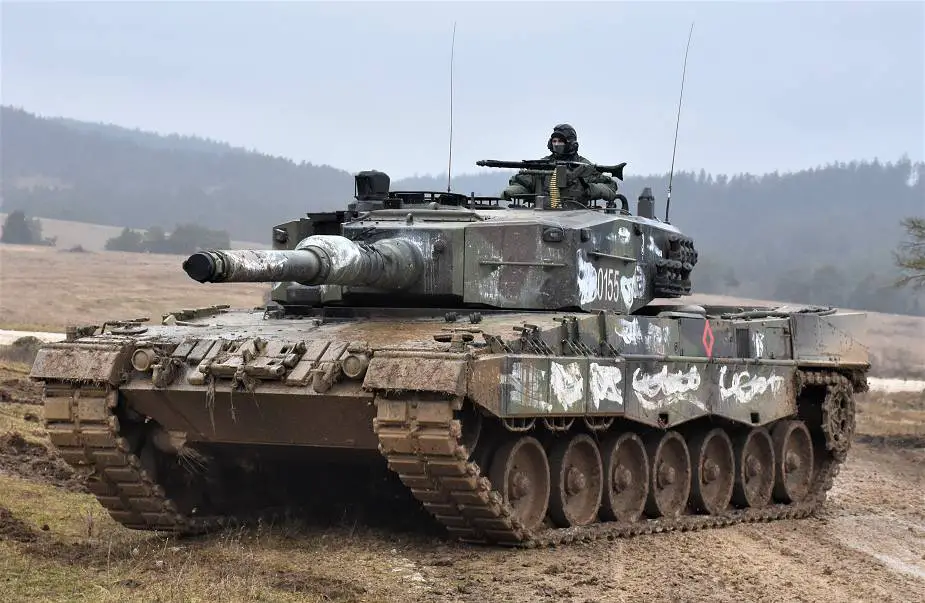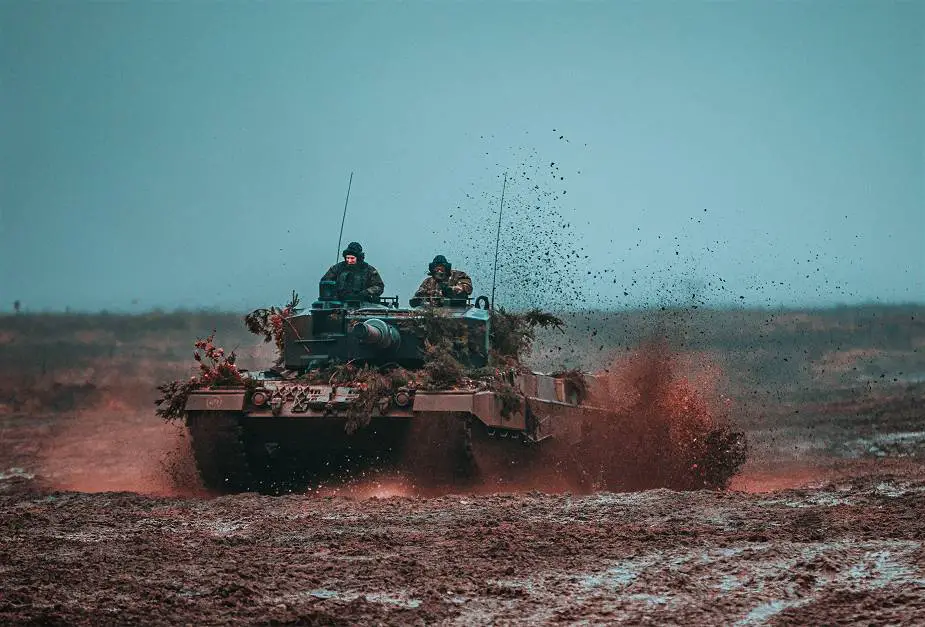According to information published on Russian social networks, Russian soldiers appear to fear encountering German Leopard 2 tanks on the battlefield in Ukraine. Propaganda videos even exist showing how to destroy the Leopard 2 tanks. Like the German Tiger in World Word 2, the Leopard 2 is considered as a highly efficient tank killer for Russian troops.
Follow Army Recognition on Google News at this link

A Leopard 2 A4 tank from the 1st Tank Battalion, 10th Armoured Cavalry Brigade (Polish), pushes to a staging point at the Joint Multinational Readiness Center, Hohenfels Training Area, Germany, January 29, 2022. (Picture source U.S. DoD)
According to several military experts, the German Leopard 2 is considered one of the best tanks in the world in terms of mobility, protection, and firepower. However, the leopard 2 has never faced Russian tanks in combat unlike the British Challenger 2 or the American M1 Abrams tanks.
The Challenger 2 is a British main battle tank that entered service in 1998. It has been used in combat operations, during the Gulf War and more recently in Iraq and Bosnia, and has a reputation for high survivability and mobility.
The M1 Abrams is an American main battle tank that faced Soviet-designed tanks in combat during the Gulf War in 1991. The M1 Abrams faced Iraqi T-55, T-62, and T-72 tanks, and was highly effective against them, due to its superior firepower, protection, and mobility.
The Leopard 2 has not faced Soviet-designed tanks in direct combat. However, its advanced capabilities, including its high mobility, protection, and firepower, make it a formidable opponent against any tank, including those of Russian design. The Leopard 2 has faced a variety of other tanks in exercises and simulations and has been found to be highly capable in these scenarios.

The primary armament of the Leopard 2 is a high-velocity 120mm smoothbore gun, which is capable of firing a variety of munitions, including armor-piercing and high-explosive. (Picture source U.S. DoD)
In terms of protection, the Leopard 2 and T-72 are both reported as main battle tanks, but they have different armor protection designs. The Leopard 2 has a composite armor of ceramic and steel materials providing excellent protection against penetration from various types of munitions, including kinetic energy penetrators and shaped charges. The armor also provides a high level of protection against penetrators, including those from anti-tank missiles. The T-72, on the other hand, has steel armor that is thicker but less effective against advanced penetrators.
The Leopard 2 is also equipped with the latest generation of optics and fire control systems offering combat capabilities during day and night against static and moving targets in all conditions and also on the move. The gunner has a dual-magnification stabilized EMES-15 sight with an integrated laser range finder and thermal image unit (WBG) which are linked to the fire-control computer. He also has an auxiliary sighting telescope FERO-Z18 with a magnification of ×8.
The tank commander uses the thermal sight, which is integrated with the gunner's EMES-15, to observe the battlefield. The picture is transmitted to the commander's PERI-R17 so he can see the same frame as the gunner. Furthermore, the commander can control all functions of the fire-control system and the weapon slave system by a computer-controlled testing board called the RPP 1-8.
The laser range-finder has a range of 9,990 m and is accurate to ±10 m with measuring distances shown to three digits, together with the fire preparation and selected type of 120 mm ammunition in the lower part of the gunner's sight.
The fire-control computer successively calculates the angle of sight and lateral angular lead for the main armament. The following parameters are taken into account: target distance (from laser range-finder), angle of tilt of the vehicle, the direction of motion in regard to the target, and ballistic data of ammunition. The data calculated by the fire-control computer are fed into the weapon slave system which guides the weapon to the line of sight of the EMES-15 or PERI-R17. The thermal image unit integrated into the EMES-15 enables the armament to be aimed and fired at night, in bad weather, or at camouflaged targets.

The Leopard 2 can reach a top speed of 72 km/h. (Picture source U.S. DoD)
The primary armament of the Leopard 2 is a high-velocity 120mm smoothbore gun, which is capable of firing a variety of munitions, including armor-piercing and high-explosive. The tank can fire the APFSDS-T (Armour-Piercing Fin-Stabilized Discarding Sabot Tracer), armor-piercing rounds, and HEAT-MP-T (High Explosive Anti-Tank) multi-purpose rounds. The APFSDS-T is able to penetrate around 450 mm of rolled homogenous armor equivalency at 2,000 m range. According to German army experts, it is estimated that the Leopard 2 120mm ammunition could penetrate the frontal armor of the Russian T-72 tank at a range of 2,000 m and the frontal armor of the T-62 tank at a range of over 4,000 m.
The Leopard 2 has a crew of four including a commander, driver, gunner, and loader. Unlike the T-72, it does not have a loading system, but according to German military experts, the tank crew is able to have a rate of fire similar to a tank equipped with an automatic loading system. The Leopard 2 carries a total of 42 120mm ammunition while the T-72 has a total of 45 rounds of 125 mm.
The Leopard 2 is powered by an MTU MB 873 Ka501 turbocharged diesel engine developing 1,500 hp at 2,600 rpm coupled to Renk HSWL 354 hydrokinetic planetary gear shift with 4 forward and 2 reverse gears. In terms of mobility, the Leopard 2 can reach a top forward road speed of 72 km/h and 31 km/h in reverse with a maximum cruising range of 550 km. The Russian T-72 can reach a top road speed of 60 km/h with a maximum cruising range of 480 km or 550 km with additional fuel drums.















